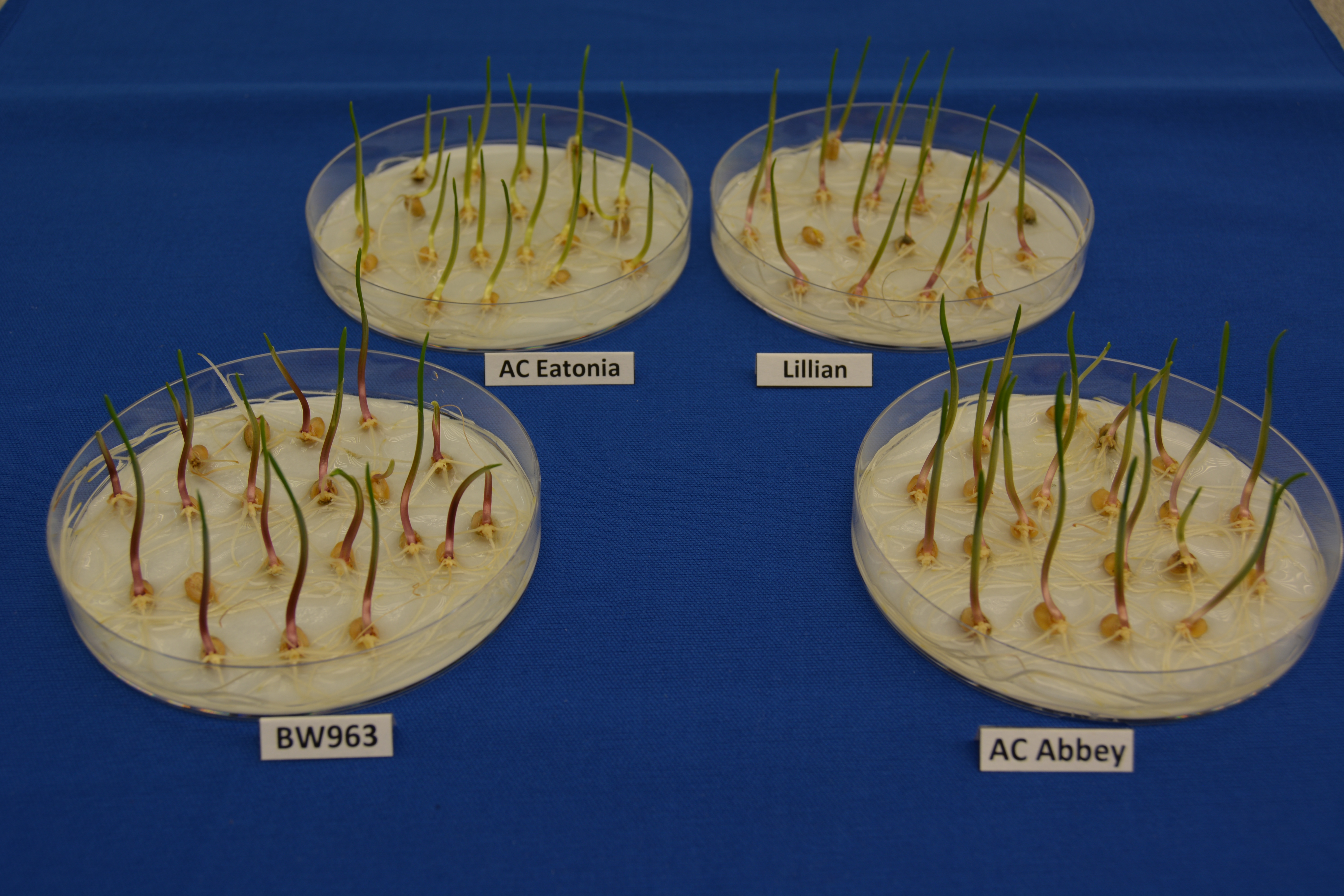AAC Concord
| Denomination: | 'AAC Concord' |
|---|---|
| Previously Proposed Denomination: | 'BW963' |
| Botanical Name: | Triticum aestivum |
| Applicant/Holder: |
Agriculture & Agri-Food Canada, Swift Current Research and Development Centre 1 Airport Road P.O. Box 1030 Swift Current, Saskatchewan S9H 3X2 Canada |
| Breeder: |
Richard Cuthbert, Agriculture & Agri-Food Canada, Swift Current, Saskatchewan |
| Agent in Canada: |
Agriculture & Agri-Food Canada Office of Intellectual Property and Commercialization c/o Shannon Whyte 107 Science Place Saskatoon, Saskatchewan S7N 0X2 Canada Tel: (204) 999-9887 |
| Application Date: | 2015-04-26 |
| Provisional Protection:: | 2015-04-26 |
| Application Number: | 15-8611 |
| Grant of Rights Date: | 2017-11-09 |
| Certificate Number: | 5573 |
| Grant of Rights Termination Date: | 2037-11-09 |
Variety Description
Varieties used for comparison: 'AC Eatonia' and 'Lillian'
Summary: The intensity of anthocyanin colouration of the coleoptile of 'AAC Concord' is strong to very strong whereas it is absent or very weak for 'AC Eatonia' and weak to medium for 'Lillian'. The intensity of anthocyanin colouration of the flag leaf auricles of 'AAC Concord' is absent or very weak whereas it is of medium intensity for 'AC Eatonia'. The flag leaves of 'AAC Concord' are narrower than those of 'Lillian'. 'AAC Concord' heads earlier than 'Lillian'. At maturity, the plants of 'AAC Concord' are taller than those of 'Lillian'. The shape of the lower glume shoulder of 'AAC Concord' is straight whereas it is elevated for 'AC Eatonia'.
Description:
PLANT: common dark red spring type, semi-erect growth habit at the 5 to 9 tiller stage, medium frequency of plants with recurved flag leaves, heads and matures mid-season
SEEDLING (4-leaf stage): strong to very strong intensity of anthocyanin colouration of the coleoptile, glabrous sheath and blade of the lower leaves
FLAG LEAF: absent or very weak intensity of anthocyanin colouration of the auricles, weak glaucosity of the sheath and lower side of leaf blade, glabrous blade and sheath
SPIKE: medium to strong glaucosity at heading, parallel sided in profile, medium density, awnlets present, white at maturity, inclined attitude, absent or very sparse hairiness of apical rachis segment
CULM: absent or very sparse density of hairiness of uppermost node, medium to strong glaucosity, straight neck
STRAW (AT MATURITY): thick in cross section
LOWER GLUME: medium length and width, glabrous
LOWER GLUME SHOULDER: broad to very broad, straight shape
LOWER GLUME BEAK: short, straight shape
DISEASE REACTIONS: resistant to Leaf rust (Puccinia recondita) and Stem rust (Puccinia graminis f. sp. tritici), moderately resistant to Common bunt (Tilletia caries, Tilletia foetida), moderately resistant to moderately susceptible to Loose smut (Ustilago tritici), moderately susceptible to Fusarium head blight (Fusarium species and specifically Fusarium graminearum)
Origin & Breeding History: 'AAC Concord' (experimental designation 'BW963' and 'B0501-AL04D') is derived from the cross 'Lillian' / 'Journey' // '9505-LP03A' made in 2005 at the Semiarid Prairie Agricultural Research Centre of Agriculture and Agri-Food Canada, Swift Current, Saskatchewan. About 10,000 F2 seeds were inoculated with common bunt and planted in a rust epiphytotic nursery. Disease-free, solid-stemmed and early maturing individual plants were selected, threshed and selected for kernel characteristics. Seed of the F3 generation was grown in a contra-season nursery in New Zealand where selections were made based on maturity, plant height and straw strength. The F4, F6 and F8 lines were planted and screened in various locations in Saskatchewan and Alberta (Swift Current, Stewart Valley and Lethbridge) and assessed for agronomic performance, end-use suitability and response to wheat stem saw fly. The F5 and F7 generations were grown in nurseries in New Zealand. Selected F8 lines were screened for resistance to mixtures of loose smut and common bunt. Through this breeding process, the experimental line, 'B0501-AL04D', was selected and in 2010, was evaluated in the Western Bread Wheat A_1 test and in the Western Bread Wheat B test in 2011. From 2012 to 2014, 'B0501-AL04D' was tested in the Western Bread Wheat Cooperative tests as 'BW963'.
Tests & Trials: Tests and trials were conducted at the Semiarid Prairie Agricultural Research Centre, Swift Current, Saskatchewan during the 2014 and 2015 growing seasons. Plots consisted of 4 rows, each 4 metres long with an inter-row spacing of 23 cm with 4 replications per variety arranged in an RCB design. There were 40 leaf and 20 spike measurements. Plant heights were recorded as an average of the 4 replicated plots with 20 measurements taken in 2014 and 16 measurements taken in 2015. Means are based on a two year average except for plant height where individual means are presented each year. Mean differences are significant at the 5% probability level based on LSD values.
Comparison tables for 'AAC Concord' with reference varieties 'AC Eatonia' and 'Lillian'
Flag leaf width (mm)
| 'AAC Concord' | 'AC Eatonia' | 'Lillian' | |
|---|---|---|---|
| mean (LSD=3.1) | 16.0 | 15.0 | 19.1 |
| std. deviation | 1.1 | 1.0 | 1.4 |
Days to heading (days from planting to when 50% of heads fully emerged from boot)
| 'AAC Concord' | 'AC Eatonia' | 'Lillian' | |
|---|---|---|---|
| mean | 60 | 59 | 63 |
Plant height (including awns and awnlets) (cm)
| 'AAC Concord' | 'AC Eatonia' | 'Lillian' | |
|---|---|---|---|
| 2014 mean (LSD=1.4) | 104.7 | 110.8 | 101.2 |
| 2014 std. deviation | 2.8 | 2.4 | 4.4 |
| 2015 mean (LSD=5.0) | 101.0 | 100.8 | 90.8 |
| 2015 std. deviation | 6.4 | 9.2 | 7.6 |
Click on image for larger view

Wheat: 'AAC Concord' (bottom left) with reference varieties 'AC Abbey' (bottom right), 'AC Eatonia' (top left) and 'Lillian' (top right)
- Date modified: